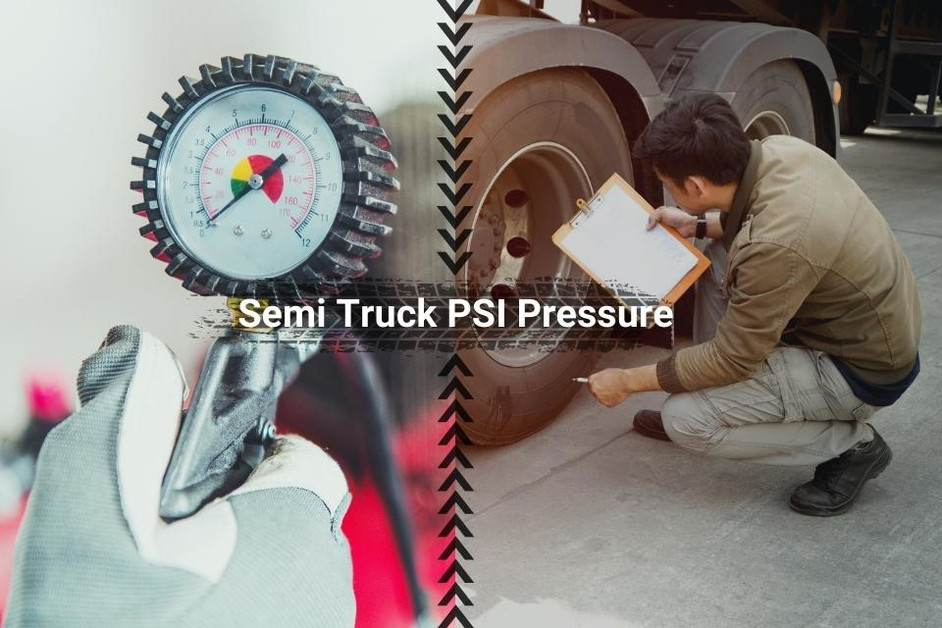What PSI Should Semi Truck Tires Be?
Getting the right tire inflation pressure on your semi-truck can prevent underinflation (wearing down the tires and increasing rolling resistance) and overinflation (blowout on the side of the road).
Adding the appropriate amount of air pressure to your big rig will keep you and other passerby drivers safe.
To find the correct PSI for your tires, check your owner’s manual, or find it on the commercial vehicle’s tire placard.
The number is based on various factors, like:
- Weight on the truck
- Size and type of tires
- Common use of vehicle (class 5 - commercial work, class 7 - heavy duty, or class 8 -semi)
Recommended PSI for a Semi Truck
For a fully loaded, commercial semi-truck:
- Front Tires: 100-130 PSI
- Rear Tires: 85-120 PSI
Dangers of Incorrect Tire Air Pressure
The incorrect amount of air pressure can affect:
- Carcass strength
- Stability and grip
- Resistance to curb or road impacts
Underinflated Tires
22 PSI or less.
It increases the risk of a tire blowout at high speeds due to heat buildup, and uneven wear on the tire’s outer edge. You also run the risk of irreversible internal damage to the tire, and hydroplaning risk thanks to reduced handling and stability.
Overinflated Tires
Cold tire pressure shouldn’t be 145 PSI or more.
Overinflated tires, even if it’s just 10 to 20 PSI over the normal pressure range – can result in higher rolling resistance, which is less fuel efficient (higher fuel costs). This leads to uneven, rapid deterioration of tire tread and the increased risk of a blowout. The air in your tires heats and expands while on the road.
Tire Blowout Prevention Tips
- Maintain recommended pressure.
- Check PSI cold, not after tires have been running on the road.
- Inspect tread, rotation, and alignment.
How the Right PSI Amount Extends Your Tire Lifespan
Correct tire pressure extends the lifespan of your semi truck tires, resulting in added safety, fewer roadside emergencies, and lower maintenance costs. You get to extend your tire life.
Breaking Down the Basics of Semi Truck Tire PSI
What is PSI?
PSI (pounds per square inch). It’s how we measure air pressure in the tire.
Why does air pressure matter? It directly impacts how well you handle the truck, smoother braking, and stronger fuel economy.
Follow the manufacturer’s number? It’s an accurate way to find the correct PSI for your specific tire size/brand.
Visual inspections, like “thumping” the tire, aren’t good enough. You need an air pressure gauge for accurate PSI level analysis.
Always confirm with the manufacturer’s specifications and tire load charts for your exact truck and tire type.
Factors That Influence the Right Tire Pressure
Load weight & distribution: fully loaded vs. partial loads.
A fully loaded big rig needs a higher PSI because if the weight isn’t spread evenly, one tire can do more work than the other which leads to faster wear-in-tear and replacement.
The pressure on the same side of the axle can’t be uneven, otherwise your tires wear down too quickly.
Temperature changes: hot tire vs. cold tire readings.
Air expands in the heat and shrinks in the cold. Seasons affect your readings. It’s important to check tires cold, before running on the highway.
Road conditions & terrain: highway vs. rough routes.
Rough terrain from a job site or backroad heats up your tires more than a smooth highway.
Tire type & size: different tires, different ranges.
All tires aren’t the same. A steer tire doesn’t have the same PSI as a wide-based drive tire. So, check the sidewall or the spec chart for the right number for your tire.
The Best Tools and Tech to Keep PSI in Check
Tire Pressure Monitoring Systems (TPMS):
Take all the guesswork out of tire pressure with a TPMS kit for your commercial truck. Get real-time PSI and temperature readings to address underinflation or overinflation issues before they cause problems.
Automatic Tire Inflation (ATI) Systems:
Keeps tires at optimal pressure while driving with ATI systems that automatically maintain the right tire pressure while driving. This is perfect for bigger fleets or long-haul owner-operators.
Digital Tire Pressure Gauges:
Gauge your air pressure reliably by upgrading to a digital air pressure gauge.
You can also use a tire pressure monitoring valve stem. These are really easy to use. You just inflate to the correct PSI level and twist on the LED capsule. If your tire pressure drops 5-10 pounds, you'll see the red LED light flash.
Tire Valve Extensions / Caps:
Save time on dual tire checks with Real Wheels aftermarket valve extensions for your semi-truck.
Be well prepared for a potential roadside emergency fix with a tire repair kit or plug kit. Have at least one quick fix hose repair kit (NTA) to backup your air hoses should they leak or rupture. And throw in a pair of wheel chocks and safety triangles to keep safe while you’re pulled to the side of a busy highway.
Extra Maintenance Practices That Impact PSI Levels
- Perform regular tire rotations to prevent uneven wear
- Alignment and tire balances to extend tire life
- Inspect the air hoses and gladhands for leaks to keep your air system sealed
Throw in mud flap hangers and guards to help protect your tires from debris. For tire protection and extra style, consider throwing in a full-radius fender for your big rig.
Add an air hose and gladhand repair kit, or a replacement/backup option, to avoid unexpected pressure loss.
Upgrade your wheel’s looks while maintaining some protection with aluminum or chrome hub covers and wheel covers.
How Often Should Semi Truck Tire Pressure Be Checked?
Tire maintenance is a critical aspect of safety inspections.
- Daily pre-trip PSI checks.
- After long hauls or big temperature swings.
- At least once a week with a calibrated gauge.
Keep Your Rig Rolling with the Right PSI & Aftermarket Tools
Experience stronger fuel economy, fewer breakdowns, and great tire longevity that comes with adding the right PSI to your truck tires.
Remember to follow the manufacturer’s instructions for your truck model; stay proactive with good tire maintenance; use quality aftermarket tools like TPMS, ATI, and pneumatic dashboard gauges for easy, accurate monitoring.
Find everything you need to monitor to your big rig at 4 State Trucks.
Recent Posts
-
Wet Line Kits for Semi Trucks 101: The Basics Explained
Ready to transform your rig into a hydraulic powerhouse? A semi truck wetline kit can do the trick. …9th Sep 2025 -
Semi Truck Battery Replacement: How to Change & Maintain Semi Truck Batteries
When it comes to your semi truck’s power system, batteries are the lifeline for nearly any app …5th Sep 2025 -
The Best Heavy Duty Shocks for Semi Trucks
Aside from your truck's engine, heavy duty shocks are among the most critical parts that that affect …25th Aug 2025 -
Air Horns for Semi Trucks: A Complete Buyer’s Guide for Drivers
Looking to add some power to your truck’s voice and match your exterior chrome-polished aesthe …22nd Aug 2025 -
Ultimate Guide: Semi Truck Fuel Tank Accessories
Wondering about the best aftermarket fuel tank accessories and parts to get? Here's a quick guide o …19th Aug 2025 -
Before You Buy: Semi Truck Deck Plates 101
Looking to cover your truck’s frame and get a little more protection, easy access to component …14th Aug 2025 -
Semi Truck Boot Brush Guide: Does it Really Keep Your Cab Clean?
Step-mounted boot brushes are aftermarket cleaning devices that attach to a truck’s exterior s …11th Aug 2025 -
CB Radios Ultimate Guide
“10-4 Roger.” Despite the rise of messaging apps, GPS devices with voice-activated mess …6th Aug 2025 -
Semi Truck Polishing Guide
Polishing your semi truck can seem like difficult undertaking. However, with the right tools and kno …31st Jul 2025













